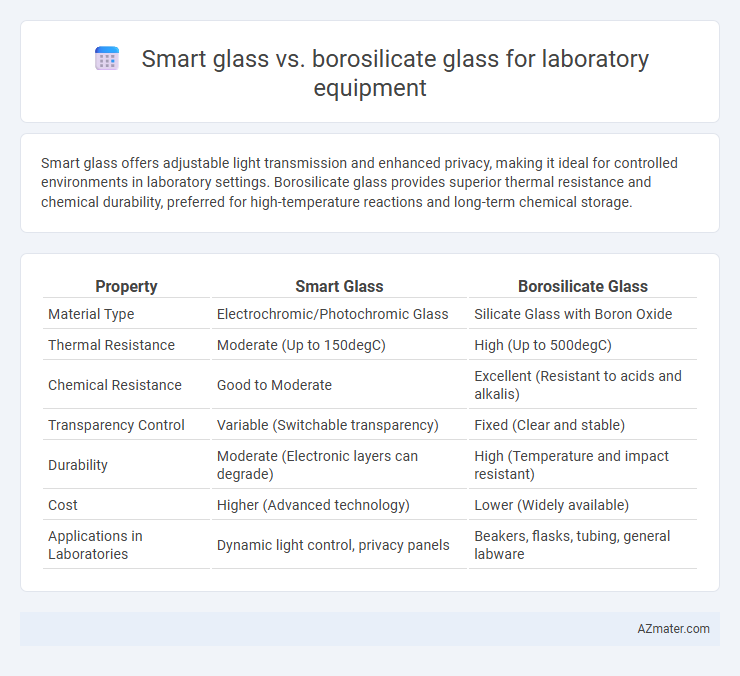Smart glass offers adjustable light transmission and enhanced privacy, making it ideal for controlled environments in laboratory settings. Borosilicate glass provides superior thermal resistance and chemical durability, preferred for high-temperature reactions and long-term chemical storage.
Table of Comparison
| Property | Smart Glass | Borosilicate Glass |
|---|---|---|
| Material Type | Electrochromic/Photochromic Glass | Silicate Glass with Boron Oxide |
| Thermal Resistance | Moderate (Up to 150degC) | High (Up to 500degC) |
| Chemical Resistance | Good to Moderate | Excellent (Resistant to acids and alkalis) |
| Transparency Control | Variable (Switchable transparency) | Fixed (Clear and stable) |
| Durability | Moderate (Electronic layers can degrade) | High (Temperature and impact resistant) |
| Cost | Higher (Advanced technology) | Lower (Widely available) |
| Applications in Laboratories | Dynamic light control, privacy panels | Beakers, flasks, tubing, general labware |
Introduction to Laboratory Glass Types
Laboratory glass types primarily include smart glass and borosilicate glass, each serving unique functions. Borosilicate glass is prized for its thermal resistance, chemical durability, and low thermal expansion, making it ideal for heat-intensive experiments. Smart glass incorporates electrochromic technology, enabling control over light transmission, which aids in protecting sensitive samples from UV exposure and enhancing experimental accuracy.
Overview of Smart Glass Technology
Smart glass technology utilizes electrochromic, thermochromic, or photochromic materials to control light transmission, enabling dynamic opacity changes in laboratory settings. Unlike borosilicate glass, which is prized for its thermal resistance and chemical durability, smart glass offers real-time light modulation for enhanced privacy and energy efficiency. This technology supports applications requiring controlled lighting conditions without compromising structural integrity or visibility.
Properties of Borosilicate Glass
Borosilicate glass is renowned for its exceptional thermal resistance, with a low coefficient of thermal expansion (about 3.3 x 10^-6 /degC) that minimizes stress under rapid temperature changes, making it ideal for laboratory equipment that encounters heating and cooling cycles. It exhibits high chemical durability, resisting corrosion and reaction with most acids, bases, and organic solvents, ensuring the integrity of experiments and longevity of glassware. Compared to smart glass, borosilicate glass prioritizes stability and resistance rather than dynamic light control, making it a preferred choice for precise, resilient lab instruments.
Comparative Thermal Resistance
Smart glass exhibits variable thermal resistance depending on its type, with electrochromic variants showing moderate heat tolerance suitable for controlled environments, whereas borosilicate glass offers superior and consistent thermal resistance up to approximately 450degC, making it ideal for high-temperature laboratory applications. Borosilicate glass's low coefficient of thermal expansion (~3.3 x 10^-6 /degC) ensures minimal stress and high durability during rapid temperature changes, whereas smart glass generally has higher expansion rates that may limit its use in extreme thermal cycling. Laboratories requiring robust thermal performance for heating, sterilization, and chemical reactions prefer borosilicate glass due to its proven reliability and resistance to thermal shock.
Chemical Durability and Reactivity
Borosilicate glass offers superior chemical durability and minimal reactivity, making it the preferred choice for laboratory equipment exposed to aggressive chemicals and high temperatures. Smart glass, while innovative with adjustable opacity, typically has a resin or polymer layer that may degrade or react under harsh chemical conditions, limiting its use in chemical-intensive environments. Laboratories prioritize borosilicate glass for reliable resistance to acids, alkalis, and solvents, ensuring safe and uncontaminated experiments.
Optical Clarity and Transparency
Smart glass offers adjustable optical clarity and transparency through electrochromic technology, allowing precise control over light transmission, which is ideal for environments requiring dynamic visibility conditions. Borosilicate glass provides superior inherent optical clarity and high transparency with minimal distortion, making it excellent for consistent, high-precision laboratory observations. The choice depends on whether variable light modulation or stable, clear viewing is prioritized in laboratory applications.
Cost Analysis and Budget Considerations
Smart glass typically incurs higher upfront costs compared to borosilicate glass due to advanced technology and manufacturing processes. Borosilicate glass remains cost-effective and widely preferred for laboratory equipment because of its durability, chemical resistance, and lower production expenses. Budget considerations favor borosilicate glass when prioritizing long-term affordability and reliable performance in standard lab settings.
Applications in Laboratory Settings
Smart glass offers dynamic light modulation ideal for laboratories requiring adjustable privacy and controlled light exposure during sensitive experiments. Borosilicate glass provides exceptional thermal and chemical resistance, making it suitable for high-temperature reactions and handling corrosive substances. Both materials serve specialized roles, with smart glass enhancing environmental control and borosilicate glass ensuring durability and safety in rigorous laboratory applications.
Safety and Environmental Impact
Smart glass offers enhanced safety in laboratory environments by providing adaptive opacity that reduces glare and prevents exposure to harmful light, minimizing eye strain and accidents. Borosilicate glass, known for its thermal resistance and chemical durability, ensures laboratory safety by withstanding high temperatures and corrosive substances without breaking or contaminating samples. Environmentally, smart glass reduces energy consumption through light modulation, while borosilicate glass is recyclable and has a long lifespan, decreasing laboratory waste and environmental impact.
Future Trends in Laboratory Glassware
Smart glass and borosilicate glass represent contrasting innovations in laboratory glassware, with borosilicate glass renowned for its thermal resistance and chemical durability, making it a staple in traditional lab equipment. Smart glass, equipped with adaptive light modulation and enhanced safety features, is emerging as a future trend, offering dynamic control over transparency and environmental stability in labs. The integration of smart glass technology is expected to advance laboratory safety protocols and energy efficiency, signaling a shift towards more interactive and intelligent glassware in scientific research environments.

Infographic: Smart glass vs Borosilicate glass for Laboratory equipment
 azmater.com
azmater.com